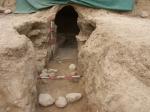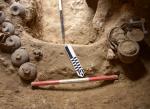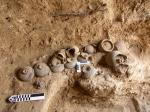Summary (English)
This was the first campaign on the site of Montecchio undertaken by Perugia University. In this phase the investigation looked at the development in antiquity of a part of the territory of Montecchio, mainly concentrating on the land along the Fosso di San Lorenzo, characterised by the presence of a vast necropolis in use between the 7th/6th century B.C. until the late 4th- early 3rd century B.C.
The excavations concentrated on the area situated NW of the group of burials identified in the past and which can be visited in the locality of Raiano, where no research had been carried out to date that aimed at the actual understanding of the necropolis’ size.
The investigations revealed:1) a structure c. 7.8 m long, on an east-west alignment, made up of unworked medium sized stones in a dry-stone construction. The most interesting finds were the heavy bucchero, coarse wares, and a few black glaze fragments datable to the late 2nd century-early 1st century B.C., which may constitute the site’s terminus post quem.
2) a chamber tomb on a N-S alignment with the entrance facing south, which presented clear traces of collapse, tampering and flooding. During the removal of the dumped layers, a continuation of the underground tomb was identified, whose vault was not completely collapsed.It was excavated in the bedrock (of sedimentary origin) and was entered via a short open-air dromos in counterslope with respect to the hill slope. It had two coaxial chambers with benches, which contained burials without grave goods. All the materials recovered date the tomb to the mid-late 6th century B.C. covering a relatively short period with respect to the other excavated burials; it also denotes the almost complete influence of Velzna- Orvieto over this populous area situated on the left bank of the Tiber.
- Stefano Spiganti - Intrageo
Director
- Grassigli Gian Luca - Dipartimento di Lettere. Lingue, Letterature e Civiltà antiche e moderne, Università degli Studi di Perugia.
Team
- Francesco Pacelli
Research Body
- Università degli Studi di Perugia
Funding Body
- Comune di Montecchio






![Download [PDF]](/excavation/skins/fasti/images/results/download_sml.png)


